2016-04-30
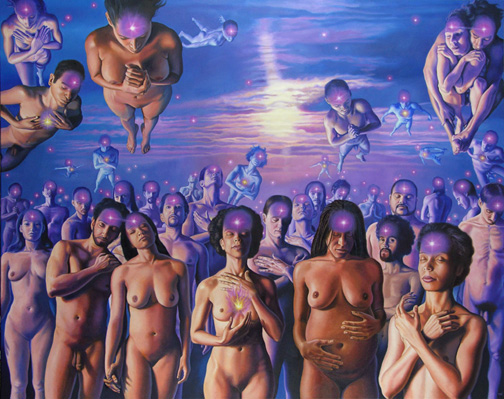
There is always a lot to say about any bit of art. Composition, color, rhythm and spacing, media, and a dozen other ideas are always available for discussion. Mostly, though, people want to look at art. Isn’t this one nice? It’s calming, and soothing. How blue it is! The people in it look so peaceful. Don’t you think you would like these people, if you met them in real life? It is as if they are actually praying for you, you personally, to have peace, to be at peace. Isn’t that powerful? Isn’t that compelling? All the techniques and methods of art are all subservient to the lasting impression that art leaves in our minds. And isn’t that really the true power of art?
Saying that a person needs to be attractive if they want to attract people is redundant; it is just saying the same thing twice. It would be better to describe what sorts of behaviors attract people: kindness, active listening, hospitality, fairness, generosity, just plain good citizenship. Are those qualities what come to mind first when you think of nudists? Perhaps it is, or perhaps it is not. That is the image we need to project, indeed, if we want to be successful in attracting new members and new opportunities. Corporate and governmental bodies will say what they will about the nudist movement, and unless we become wealthy or powerful there is not much we can do about that. We can always influence the people we actually interact with, however, and there is nothing the government or corporations can do about that. Make sure that the people around you feel that nudists are the kind of people they would want to be with. And isn’t that really what nudism is about?
2016-04-29

Underpainting is a technique used in fresco and oil painting to create a base atop of which layers of translucent color will be glazed to create the final painting. Some artists use an underpainting to set tone but do not intend the underpainting to contribute directly to the final image, while other artists expect that the underpainting will provide color and shading that will be visible in the final work. Various terms such as “verdaccio” or “grisaille” have been used to describe underpainting, usually in reference to the colors used. Many modern schools of art emphasize a “wet-on-wet” technique, which is faster and more fluid, but requires more finesse to deal with the unpredictable nature of mixing pigments. If properly created, an underpainting will guide the artist and provide a good foundation for the final piece.
Every organization requires a core of people to maintain the values and momentum. These people often helped found the organization or have direct ties to the ones who did. They believe in the cause, and are have long-term commitments to the organization. It is their values that inform the functions the organization performs. They are not always the people that newcomers first meet, or ever meet if the organization is large enough, but they are there and their influence is always felt. As nudists we need to know that our leaders share our belief in the value of social, mixed-gender, non-sexual nudity and that they are committed to preserving the foundation of naturism created so long ago.
2016-04-28

Here is a very colourful impressionist image that gives all the information necessary to enjoy the day at the beach with the subjects without being overly explicit in their depiction. According to Encyclopædia Britannica, Erich Heckel (1883-1970) was born in Döbeln, West Germany and died in Radolfzell, West Germany. He was a painter, printmaker, and sculptor and was one of the founding members of Die Brücke (“The Bridge”), German Expressionist artists who were very influential in their time. The bulk of his work consisted of woodcuts of landscapes and nudes and is characterised, at least in the early years, by bright vivid colours. It wasn’t until he moved to Berlin in 1911 that his work became more subdued as part ‘The Bridge’ movement. He had also briefly studied architecture in Dresden the year before the inception of Die Brücke.
2016-04-27
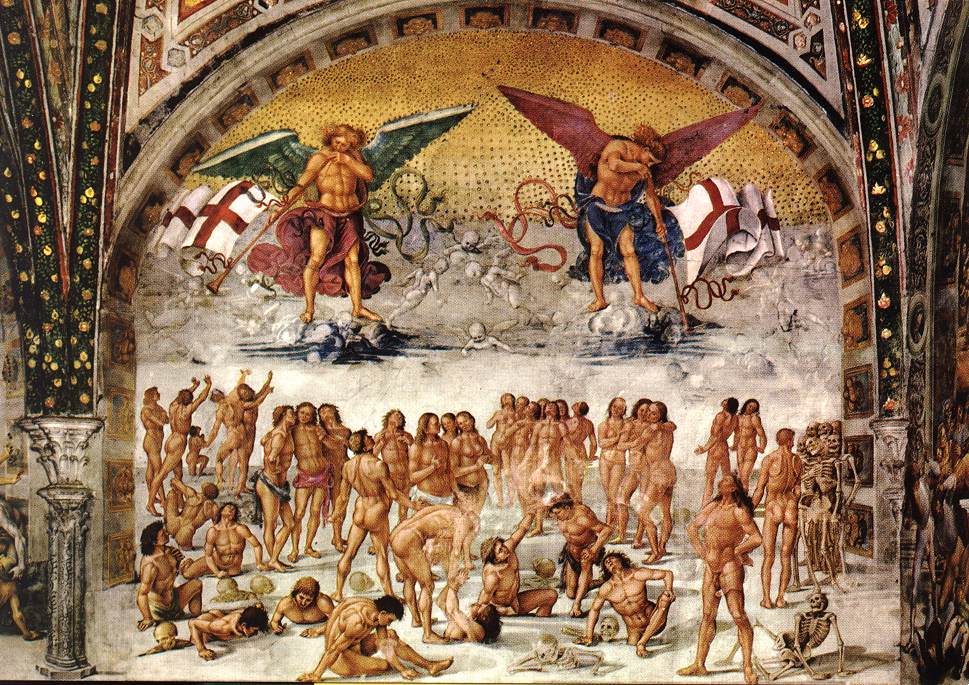
Fresco is an ancient art media where pigment is applied to wet plaster, which then sets, permanently binding the pigment in place. First used as early as 1500 BCE, fresco (or buon fresco, to differentiate it from fresco a secco, paintings on dry plaster) is very durable, although difficult to execute. Many of the famous pieces of the European Renaissance, such as the ceiling of the Sistine Chapel, were done in fresco. Because the plaster had to be wet when painted, the painting had to be done in sections small enough to be finished in seven to nine hours, and often required a team of assistants.
Many large religious art works in Medieval and Renaissance Europe were didactic in nature. In other words, they were teaching tools, meant to educate the illiterate masses in the basics of Christian theology. One of the basic tenants was the resurrection from death, promised to the faithful in the New Testament. Those who saw these works would have also listened to explanations of what they were viewing. The very dramatic nature of the art helped reinforce the ideas of the religion. Nudity was a basic element of life, and here it was prominently displayed and referenced in an ecclesiastical setting, a standard of normalcy that has existed until the present.
2016-04-26

According to Wikipedia, from whence this image comes The Vision of St. John (also called ‘The Opening of the Fifth Seal’ or ‘The Fifth Seal of the Apocalypse’) was painted for the Church of St. John in Toledo, Spain in the last years of El Greco’s life. And according to the Metropolitan Museum of Art in New York City, where the painting is held, says that it is unfinished. Unfortunately, the top portion of the painting was destroyed in 1880. The bottom half of the painting is described as referring to ‘profane love’ whilst the missing top portion is assumed to referring to divine love. Whether this is the case we shall never know.
Nudism is not profane, nor is it perverted or any other similar pejorative. It is simply a lifestyle based upon the simplicity of not needing or desiring to wear clothing. Unfortunately, in our ultra-conservative environment in the United States, this is still looked on as being profane and, in many cases, pornographic – when this couldn’t be further from the truth. Nudism/naturism is by its very existence nonsexual, but trying to get the masses to understand this is not an easy task. So we put up these paintings every day to show that nudity has been accepted in Europe and in other parts of the world as de rigeur and even natural and normal in many instances. We urge you to go to our page at artdayonline.org to check out the many examples in our monthly galleries of nudist-oriented artwork. We have many examples to showcase there.
2016-04-25

There are times when art is defined more by what it is not than by what it is. Typically, however, this is more of a false dichotomy, for any piece of art is the sum of what came before it, and if it is differentiated from a recent ancestor then it still shares many characteristics with it. Post-expressionism has sometimes been defined as that which is not Expressionist, but really it is the art of the early twentieth century, but usually in reaction to Expressionism. It still is informed by the movements that preceded it such as the Salon movement and Impressionism, with their emphasis on emotion and subjective nature, and other surrounding and contemporary movements such as Magic Realism.
Nudists may be reacting against the puritanism in society today, but that does not change the fact that we live in society. Because society views nudity as inevitably sexualized, nudists go out of their way to show a nudity that is asexual. Because society views nudists as populated by odd folk, nudists sometimes go out of their way to show ourselves engaged in average behaviors. Still, when we try to show asexuality we do so using society’s definition of sex, and when we want to appear average we must compare ourselves to the average of society. Even as we try to step out of society, we are still defined by the borders of that society. There is nothing wrong with that — it is inevitable — so long as we all have reference to an absolute standard of acceptable behavior and adhere to it. No one should react badly if we do that.
2016-04-24

Anyone who has worked in art for longer than a week comes to the realization that the media the artist uses to create art both informs and confounds the creative process. In other words, the stuff of art both makes the art possible, and harder to create. Natural materials present the opportunity to use their natural beauty, but also enforce certain modes of creation. Wood has a grain which can turn a blade in unexpected ways, and it can have knots which show both fantastic detail and can introduce weaknesses. An artist who works with wood must learn about wood as well as learn about art, and to learn about wood is to learn about trees and forests and soil and water.
Creating any organization requires raw materials: money, time, opportunity, media, and above all, people. No two people are the same, and each person has their strengths and weaknesses. Any organization will bear the marks of the persons who create it, and the persons who compose it. When organizing, take into account the motivations of the members, the leaders, and the audience. There is beauty and weakness in everyone, and that both allows and complicates the creation and maintenance of any organization. Take into account the hopes and fears and prejudices and strengths of the people you have to work with.
2016-04-23
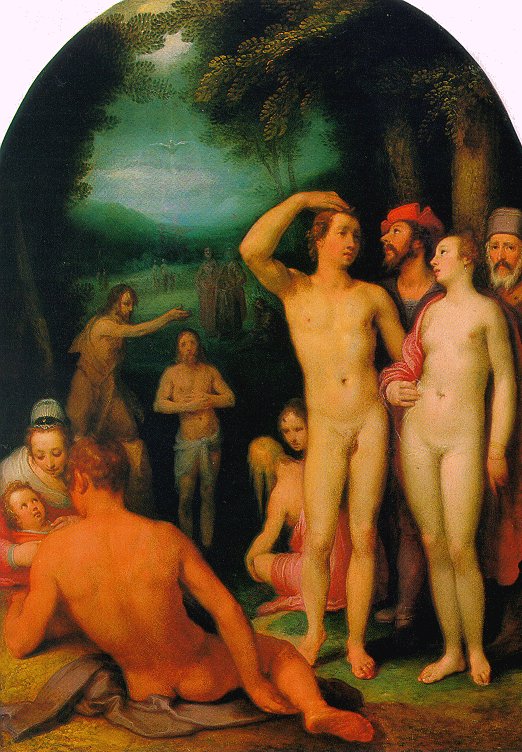
Most paintings are done either on paper, canvas, or wood. Some few artists, however, choose a different ground to paint on: copper. Thin sheets of copper, sometimes leftover from printmaking, were painted on using oil paints. The metal’s greater stiffness both allowed for finer detail and resisted excessive changes in size with temperature, reducing cracking. The mix of copper and oil paint created art that was more durable and long-lasting, resistant to moisture, corrosion, or damage.
Often, in discussions of character, the idea of “toughness” is brought up as a desirable characteristic, and indeed it is. It would be a mistake to confuse toughness with either a spartan aspect or an inscrutable one; one does not become tough merely by being mean or rigid. Toughness acknowledges that some forces in life are too great to be merely withstood, and that a degree of flexibility is needed, without abandoning essential values. As people who live an unpopular lifestyle, we need be willing to explain ourselves and be willing to allow others to explain themselves, all while resisting the urge to compromise of basic beliefs.
2016-04-22

Susannah Martin is a German-based artist who paints her subjects in natural surroundings. She explains her art this way:
‘The history of the painted nude in landscape documents exactly [an] eternal longing. Setting aside for a moment, any erotic motivations, the nude has always also been a symbol for man in his purist form, his original form, his primordial form. Stripped of all social indicators; clothing, possessions , etc., he exists independent of identity in a time of pure being ( ein Zeit des Seins). Being is our eternal home. Nature does not possess an identity, it is. The nude in a natural setting has always been associated with our return to a time of pure being, a return home.’
Her statement pretty much sums up the philosophy I hold about naturism/nudism. Without the ‘status symbol’ of a $1000 Armani suit or an equally expensive ball gown, we are all the same underneath – just a pile of skin, muscle tissue, organs and bones. We don’t and can’t know whether the people in this painting are very rich or very poor – all we know is that they are people, just like the rest of us, in their ‘natural state’ (i.e. nude) in a natural setting. What could be more natural than that?
2016-04-21
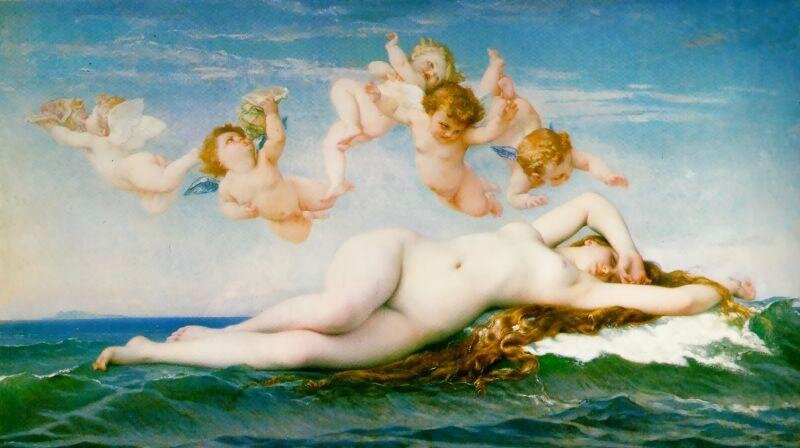
Amaury Duval is the pseudonym of Eugène-Emmanuel Amaury Pineu-Duval so as not to be confused with his father Amaury Duval, a historian and diplomat. The title of the paint may be ‘The Birth of Venus’ but the website wasn’t very clear on this point. There was another image of a woman alone, standing, who looked very much like the woman in this image, which leads me to believe that the subject is identified as Venus.
From 1834 to 1836, he made toured Italy, (Florence, Rome and Naples) and became enamoured of Italian Renaissance paintings, and it shows in his style. Cherubs have been depicted in art for centuries, dating at least back to the Middle Ages and represent different roles depending on the religion they are associated with, from the guardians of the Tree of Life in Genesis to divine messengers and, according to Wikipedia, ‘ In Islamic tradition, cherubs are angels who hold God’s throne. They ask God to forgive, bless and protect the righteous.’ They seem to frequently be attendant at births of sacred or divine figures. In any event, they are a popular subject of art throughout the centuries and are perhaps the most represented figures in religious art.
2016-04-20

Art is always a product of the age in which it was created. Even if any particular artist could manage to transcend the styles and opinions of their day, no mean feat in itself, that artist may find that their art is actually a reaction against those very styles and opinions, and thus still is rooted in their own era. The technology of an era also dictates what sort of art can and will be produced. Very few books are being produced today using movable type and woodcuts, and it is fairly safe to say that no books at all were produced in 1492 using digital laser printers. Indeed, the materials and techniques used to create art are so idiosyncratic to the time the art was made that scholars can date handwritten text to within a decade (in some cases) just by looking at the style of lettering and the composition of the ink.
It is a fair bet to say that the human body has not changed significantly in shape or design in the last few millenia. What the nude figure looked like in the sixteenth century is essentially what it looks like today. You would not know that, however, by looking at the depiction of the body over the centuries. Comparing Ruben’s healthy women to today’s photoshopped waifs is just a sample of the wide and interesting variation that can be found in art. It is true that any artist will follow their own tastes when sketching a nude, but those tastes are often shaped and cultured by the society around, particularly if that artist is crafting for a more commercial purpose. After all, if you want to attract customers, it is better to paint attractive people. The young, healthy body remains the gold standard for artists, as biology dictates, and the different ways it is shown and showcased can keep the student of the arts occupied for ages.
2016-04-19
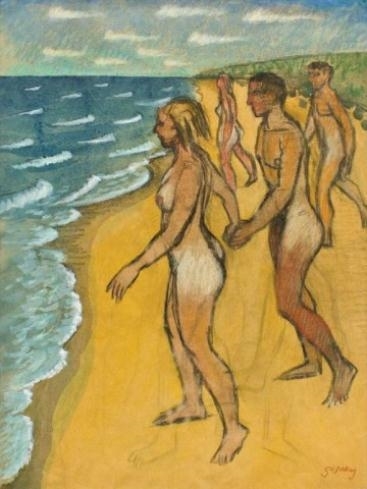
The experience of viewing two-dimensional art is very similar, regardless of the medium (oils, acrylics, watercolors, pastel, etc.), but the experience of creating art is very dependent on the materials used to make it. Typically the first media that people are exposed to, watercolor paints and dry pastels, are very different in how they are applied and manipulated, but they both share a key similarity. Both are pigments bound by a binder, and traditionally both use the same material for a binder: gum arabic. Gum arabic is made from the hardened sap of the acacia tree, and is a natural, water-soluble blend of complex proteins, sugars, and carbohydrates. It is primarily used in the food industry, but is also used a lot in the arts, both as a binder and as an adhesive. You may have never heard of it, and probably have never seen it, but it truly is a substance that holds the world of art together.
Holding things together these days can be quite a feat. Our busy lives take us in all directions, and when activities or events in our lives slow down there is a tendency to drop them and move on to something more pressing. That is not the best way to foster a cause, however. Sometimes it is when the schedule lags and loosens that creativity can finally be fostered. Sometimes it is good to get bored. Many artists find that a combination of stress and boredom can lead to periods of fantastic creative output. It can be important to plan downtime into our busy schedule. Similarly, when an organization slows the pace of activity it is important to stay strong and stay together, using that lull to strengthen the organization and return to base values in preparation for future opportunities. It may not look like anything is happening, but sometimes the best growth comes from a time of doing nothing at all, so stick it out!
2016-04-18
An essential part of any education is the feedback from other people, both in the field of study and outside it, and art is no different. There are many artists who are described as “self-taught”, but relatively few artists have created a body of work for themselves without ever having seen other art, talked with other artists, or shown their art to any other person. Even Henry Darger, one of the most celebrated of the “outsider” artists, derived much of his style from advertising art of his day.
2016-04-17

Have you ever watched an artist work and marveled at how magically the image seems to flow from their hands, and been envious of their facility with the art? The reality is that mastery of any media comes easily to no one. Even one of the greatest musical talents known, Wolfgang Amadeus Mozart, once said that “it is a mistake to think that the practice of my art has become easy to me. I assure you, dear friend, no one has given so much care to the study of composition as I. There is scarcely a famous master in music whose works I have not frequently and diligently studied.” There is no substitute for hard work. It is estimated that it takes at least ten thousand hours of training and practice to become a master of any subject, be it computer programming or painting or carpentry, and other estimates run higher. No matter what talent you may have been born with, it remains true that if you want to get to Carnegie Hall, the only way is practice, practice, practice.
For the practicing nudist, life in our modern, urban society can be perplexing. We can see nudes in marble standing on the street corner, but if we strip down to join them we will end up in gaol. Every person we meet has the sum total of human knowledge available through their smart phone, and yet it can be hard to find somewhere one can go to enjoy nature au natural. It is hard. Nonetheless, like any other skill, the more you do it the easier it gets. Routes become memorized, access becomes routine, strangers become friends, the novel becomes comfortable. After a while getting natural just feels natural. A journey of a thousand miles begins with a single step, followed by a couple million more. So just start walking the nudist walk, and after a while you will make it look easy.
2016-04-16

The life of an artist in the United States is hard, but in other countries artists can face prison or worse for pursuing their art. Typically poor and out of favor with the ruling party, artists are often naked before the wrath of an offended state. Even in the United States it is not unheard of for artists to suffer persecution for what they have to say, despite strong protections for freedom of speech. Jock Sturges is a well-known example of the government using its power to harass, repress, and destroy, even when no wrongdoing is proven. Al WeiWei, Nikolai Khalezin, and Natalya Kolyada are among the thousands of artists, musicians, and writers persecuted, arrested, imprisoned, and even killed for the art they have made. The chaotic patchwork of laws and the intentional abuse of power pose a legal minefield for anyone who wants to create art that may offend. When we worship those who defend our freedom, we need to remember to light a candle on the altar of those who suffered so that we may create free.
2016-04-15
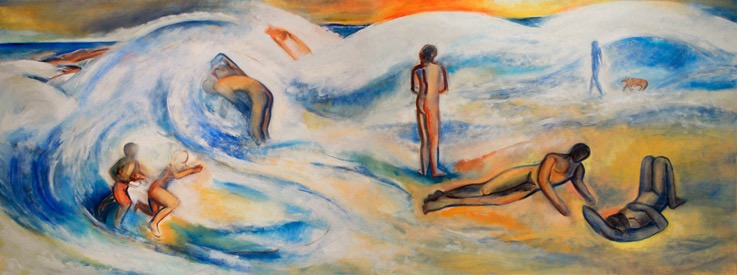
In a sense, contrast and rhythm are complimentary elements in visual art. With colors, complementary colors, when mixed, render a neutral color, typically a gray. With composition, the dynamic is slightly different. Rhythm emphasizes the sameness of elements. Evenly spaced elements of a similar size, for example, can create a visual rhythm and lend a predictability to an image that allows for a calm feeling. Contrast, on the other hand, uses the difference between elements to create visual excitement and movement. Contrast can be of light and dark, saturated or neutral colors, round or sharp shapes, large or small elements, or any number of other qualities. In the image today, we have loose, smooth, rhythmic waves contrasting with the tightly curved nudes in the foreground. The bathers, their bodies evenly spaced across the painting, vary in posture, age, action, and even color, from the young naked racers on the left to the recumbent clothed figure on the right. All this works to keep the eye moving around the page, preventing the viewer from getting bored and wandering off.
The variety that Rosenfeld brings to “In The Wave 2” is similar to the variety of opportunities available in the naturist community. Each of us has a role to play in creating a vibrant nudist community, and we can choose how we wish to participate. Some of us are leaders, lending our name and reputation to the movement. Others are hosts, opening the doors of their homes and facilities to activities and meetings. Others are organizers, helping sponsor those activities and meetings. The movement has need of many hands, be they of artists, writers, drivers, cooks, musicians, or even just the guy who shows up and brings the beer. Local organizations can be found around the globe, and there are national and international organizations as well. Step up and take your place, and your efforts will ensure that the movement will not stagnate and become boring.
2016-04-14

Born in Yorkshire, England in 1941, Timothy Duffield became an American citizen in 1976. Duffield has had many sculptures commissioned and displayed throughout the country, but most of his work can be seen around the east coast and especially in Pennsylvania where the majority of his sculptures are on display (Henry B DuPont Park, Wilmington, Delaware; World War II Memorial / Mercer Medical Center, Trenton, New Jersey; Fountain Sculpture / Schuylkill Park, Philadelphia, Pennsylvania; Fountain Sculpture / Hospital of Saint Raphael, New Haven, Connecticut; “The Pool of Siloam”; Fountain and Sculpture / Louisiana Tower, Shreveport, Louisiana; “Shreveport” / Sacred Heart Hospital, Chester, Pennsylvania; “Jesus Christ” / 301 Perimeter Center, Atlanta, Georgia; Sculpture / St. Joseph’s Hospital, Philadelphia, Pennsylvania; Three large relief sculptures / Ten Penn Center (Sun Oil Co), Philadelphia, Pennsylvania; “The Family” / Arnot Shopping Mall, Elmira, New York; Two-piece Sculpture / University City Science Center, Philadelphia, Pennsylvania; “Dream of Sky” / St. Joseph’s Hospital, Philadelphia, Pennsylvania; Sculptural lights for chapel & Memorial plaque for lobby / 8th & Lombard, Philadelphia, Pennsylvania; Sculptural Gates for housing development / E. A. Delle Donne Corporate Center, Wilmington, Delaware; Sculptural Columns and earthworks / Graduate Hospital, Philadelphia, Pennsylvania; Brick entrance, lobby, brick mural and plaza design / Lockheed Missiles & Space, Sunnyvale, California; Atria, entrances, lobbies, dining terrace, fountain design / 2000 Market Street, Philadelphia, Pennsylvania; Plaza, entrance & lobby redesign / St. Leo’s Church, Omaha, Nebraska; Brick relief, fountain & courtyard design).
‘Family’ is a very dynamic sculpture showing the joy felt by a mother and father with their two children. The fact that they are nude just goes to show that family nudism is not a perversion but rather a healthy lifestyle that takes the mystery out of the human body and shows that the family dynamic can take many forms. Nudist families tend to be very close knit groups. This is more prevalent in European countries than it is in America because Europeans aren’t as uptight about nudity as Americans are. Somehow we have become prudish in our behaviour and nudism has become shameful in the eyes of many, when in reality it is a very freeing lifestyle – you get to throw off the day’s difficulties after a hard day at work or school when you can throw off your clothes after you get home.
2016-04-13

One criticism often leveled at “modern art” (usually any art created between the 1860’s and the 1970’s. My, how time flies!) is that it is unsophisticated, unfinished, simplistic, or just unskilled. To do so is often to miss the point of that art. Whether impressionist, expressionist, cubist, or even psychedelic, that art was not intended to showcase the technical ability of the artist to reproduce exactly what can be seen with the eye, but rather to reproduce some element of reality that can sometimes be obscured by the fine details of life. Picasso once viewed an exhibition of art made by children. He said “When I was their age, I could draw like Raphael, but it took me a lifetime to learn to draw like them.” To also quote Picasso, “Art is the lie that enables us to realize the truth.”
Some have leveled the criticism at nudism that it is artificial. It is true that, given today’s society, the opportunity to enjoy nature ‘au natural’ is increasingly difficult. Nudists have to travel great distances to remote locations and pay fees to simply lie on the grass naked. Why bother? Perhaps to think like that is to miss the point. In today’s society being a nudist is making a political, religious, moral, economic, and social statement. The age of the recreational nudist, for most people, either has not arrived or has passed. We need admit that most modern nudists are working to reveal a reality that has been overlaid by the minutia of our accelerated lives, and that we are not entirely doing this for ourselves. To some we may seem childish in our behavior, when what we truly represent is child-like. We need to remember that we are trying to reveal a hidden truth.
2016-04-12

Art and artists have many goals; to teach, to persuade, to honor, to entertain. In our modern society much of the art that is created serves a commercial purpose, shilling everything from soap to spaceships. Perhaps less in quantity but still very important is the art created for educational purposes. This is not just art aimed at the primary and secondary school market, but also technical art used as illustrations in product manuals. One man’s propaganda is another man’s persuasive art, used to get across a point in a political argument. Of course, fine art is still being created, art that serves no particular purpose other than to exist. This is not to say that fine art cannot have an implicit message, or be used to teach, or even that it has no commercial value. Art for entertainment’s sake can be all of those, or just exist as itself.
For some humans, naked is not a destination, but a means to an end. They strip down to wash, to change clothes, perhaps to sleep, as part of a doctor’s visit, or for any number of other reasons, but not necessarily to just be naked. For those individuals who do disrobe specifically to be simply nude (a state of intentional un-clothed-ness), we have a name: nudists. Nudity can serve as its own state, for its own sake, with no need to reference any other activity or purpose. There are, of course, even places that are dedicated just to the state of being nude. These go by many names, but we will call them nudist venues. There are those who disapprove of these places and this purpose, but there are many more who tolerate these places so long as they are peaceful and unobtrusive. It is our goal to create these places in those locations where nudists would otherwise be unable to get nude, such as poorer urban areas. If you think this is a worthy cause, we would like to hear from you.
2016-04-11
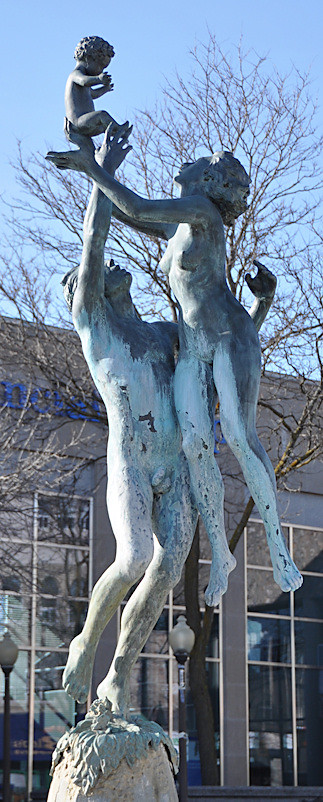
Bronze is one of the most common metals used to cast sculpture. Humans probably discovered bronze before they invented it, as copper and arsenic are found mixed in ore, and it was not until the 3000’s BCE that tin was mixed with copper for form the harder tin bronze used today. Like most copper alloys, bronze will form a protective patina when exposed to the elements, creating the verdigris commonly associated with bronze statues. Many historic and heroic figures have been created to honor people and events in an attempt to immortalize them, but these efforts have often been thwarted by later generations who, not valuing the cause that the sculptures commemorated, melted down the statues to recycle the valuable metal.
One of the most common images used to depict naturism is that of the young family. Mother, father, and baby together in the all-together is a theme repeated throughout history. There is a biologically-enforced innocence inherent in that scene that every generation discovers. Nudism itself comes in and out of favor — the 1980’s and 1990’s saw one such resurgence, producing sculptures such as this one — but the family endures. In some ways a simple nuclear family is not properly nudist, because even in times of repression young families have enjoyed their innocent nakedness in the privacy of their own homes. Once you cast it in metal and place it on the street corner, however, it takes on a public aspect, and shows the whole world that nude is neither lewd nor rude, but innocent and free.
2016-04-10

There is a temptation to say that the first art humans made was sculpture. Perhaps it was, but more likely sculpture and art made of durable materials was able to survive the millenia better, and thus the oldest surviving evidence of early art is made of stone. To be honest, sculpture is a form of art that fewer people experience on a daily basis. Our modern, electronically-connected, hyper-exposed, visually-oriented world is constantly exposing us to images, but proper sculpture is expensive and requires special care, and so we see much less of it. Having said that, it can have a greater impact on us when we see it, just because it is more rare, and more real, able to be touched and walked around and sensed in its surroundings.
Our lives are busy, full, and often just a bit chaotic. Downtime is becoming a scarce commodity. Even when we have time to relax, we often do not have a choice as to where or when, and thus must take what solace as we can snatch. Thus it is that fewer and fewer people are having the opportunity to relax and savor nature in their own natural state. Being naked outdoors in our society today requires time and planning, and often money, and all those things are becoming increasingly rare. This is a pity, because actually getting naked in the great outdoors has an impact on a person like nothing else can. It is our goal to increase the opportunities for people of all classes, races, ages, and abilities to experience naturism (non-sexual, social, mixed-gender nudity) for the first time. This does require effort and money, and we are seeking help to do this. If you are able and willing to assist, please drop us an email.
2016-04-09
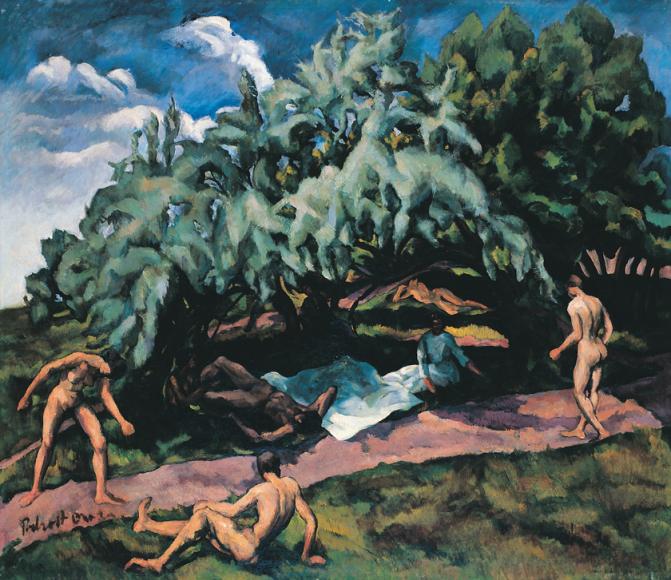
It has been said that the difference between a liberal politician and a conservative politician is that a conservative politician feels that nothing should ever be done for the first time, and a liberal politician feels that it should be done, just not while they are in office. “Avant-garde” is a French term meaning “advance guard”, and is used to describe new and different ways to make art. In the early 1900’s one avant-garde art movement was Fauvism. Described as “wild animals”, these artists favored very saturated and bold colors and simplified forms. Henri Matisse was a member of this movement. These artists took Post-Expressionism to an extreme with their colors and their abstraction.
As old as nudism is, it will always feel like something new and different to those who experience it for the first time. It is important to the movement to create a warm, welcoming, and safe environment for those who come looking for a way to express themselves. It is also important for nudists to be open to new ways of thinking and new ways of doing things. The world will not stop changing for us; if we stop growing and learning, then the world will pass us by. We must hold onto those old values and ways that still are of benefit, while still being willing to take on the new and the wild.
2016-04-08

So many people over the millenia have argued over the question of “is that art?” that relatively few have had time to move onto the topic of “whose art is it?” Questions of provenance, authorship, copying, plagiarism, forgery, and outright theft have circled throughout the art community since the first caveman plastered his (or, equally likely, her) handprint on a freshly drawn cave painting. No history of WWII would be complete without a discussion of the looting of art by the Nazis, nor is any discussion of modern military conflicts complete without a discussion of the looting and destruction of antiquities in the Middle East. Entire sections of law, both national and international, are devoted to the topic of copyright. Today’s art is another example. Is the artist here the photographer, who carefully chose the place, the subject, the angle, the camera settings, and then selected this image from the many others taken that day? Is the artist the sculptor, who labored for months or even years over this collection of bronzes? Or is the artist Life itself, which created these beautiful lives whose likeness was reproduced in both bronze and light?
Just as artists emulate each other, so ought nudists look to the example of others in how to comport themselves. There is a pattern of behavior that a proper nudist ought to follow. Always bring a towel, for example. Obey the local laws of personal space. Don’t do anything in the sauna (or pool or nudist clubhouse) that you would not do in church. Don’t stare — especially not if you are wearing sunglasses. Use alcohol only in moderation. Be clean in body and word and action. Respect the young, the elderly, animals, and property rights, and always, always, ALWAYS ask permission before taking a photo at a nudist venue or event. These are the examples that others have set for us down through the decades and centuries, and if we want to avoid both armed conflict and legal entanglements we ought to copy them.
2016-04-07
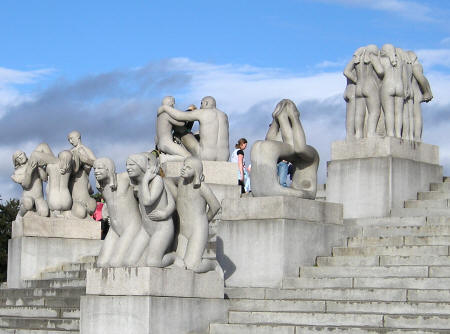
The Frognerparken (Frogner Park) in the borough of Frogner, Oslo, Norway, is a public park on the grounds of Frogner Manor and was created by Gustav Vigeland between the 1920s and 1943. The Frognerparken og Vigelandsanlegget (Vigeland installation) pictured here stand in the center of the park.The Oslo Museum is located within the manor house itself and the grounds also hold a pond, a stadium and the Frognerbadet (Frogner Baths).
The original park was centered on the manor house and was much smaller in the mid-18th century when it was created by its owner, military officer Hans Jacob Scheel. Around 1840 it was landscaped and transformed into a romantic park by a German industrialist called Benjamin Wegner, who owned it at the time until late in the century when large parts of the estate were sold to the city in the late 1800s to give room for the city to expand. The balance of the estate was then sold to the municipality of Christiania in 1896 when it became a public park. The 1914 Jubilee Exhibition was held there and this massive sculpture was begun in the early 1920s when the city government decided that the artist’s fountain and statues should be constructed there. It is the largest public sculpture park in the world created by a single artist and is the largest park in the entire city. With a couple million visitors a year it is by far Oslo’s largest tourist attraction and it is pretty clear why. It is a magnificent installation. And as the first park in Norway it was declared a national heritage site in February 2009.
Though the majority of the statues show average people engaging doing typical things such as running, wrestling, dancing, hugging, and holding hands, Vigeland did throw in some more abstract statues, including one showing an adult male fighting off a horde of babies!
All the statues are nude, showing that nudity is nothing to be ashamed of and large groups of nude people are not something to be afraid of. However, in the United States, there is a certain attitude toward nudism as a general rule and groups of nude people in particular. It could be that Americans, in large part, don’t understand the health benefits of a nude lifestyle (the skin is the largest organ in the human body and requires a certain amount of Vitamin D, which is chemically manufactured naturally in the body by exposure to the sun) or the freeing aspect of not wearing clothes. Anyone who gets nude, and we all do to bathe, should recognize this fact as our joints are not constrained by clothing and are allowed to move freely without them. We are indoctrinated from a young age that the naked body is somehow nasty and therefore should only be constrained to privacy in the bathroom or the bedroom. We are told that, except in very few circumstances, this is somehow ‘dirty’ when that couldn’t be further from the truth.
2016-04-06

This sculpture, ‘The Court of Neptune’, is a fountain that was installed in front of the Thomas Jefferson Building (formerly known as the Library of Congress) around 1897-1989. The central figure here, Neptune, God of the Sea, is seated on a rock and flanked by his two sons, the Tritons. There are also two sea nymphs riding seahorses in niches on either side of the main figure. The working fountain was designed by Roland Hinton Perry and, if you’re ever in Washington, DC you can find the Library at 1st Street SE between Independence Avenue and East Capitol Street.
Nudism and water go hand in hand. Once upon a time it was a rite of passage to go skinny dipping in the local watering hole or lake (even Huck Finn and Tom Sawyer did it), however, in the current ultra-conservative climate this practice has all but disappeared – unless you’re a Republican Congressman from Kansas, that is. Yes, that’s right folks, Rep. Kevin Yoder, on a trip to Israel in 2012 doffed his clothes and went for a nude dip in the Sea of Galilee – You know, that place where Jesus supposedly walked on water.
Meanwhile, many of our Senators, that bastion of conservatism, had a habit of swimming nude in the Senate swimming pool for decades until, after a complaint by a female senator that women were banned from the pool in 2008, this practice changed and women were then allowed to take advantage of the pool. And these Senators were being paid by taxpayers and yet they have passed laws across this country that, except in a dwindling number of places, have banned public nudity, even when it comes to swimming. And once you’ve had a nude swim, I can say from experience that you don’t ever want to wear a suit again. There is something special about the sensation of the water gliding across a completely nude body that you just don’t get from wearing a suit, regardless of how little there may be of it.
2016-04-05

Here’s a great example of Expressionist Art – a simple means of getting your point across using the most minimal of techniques. There are perhaps tens of thousands of artists around the world – the vast majority of which you will never be exposed to.
The same holds true of nudists.You may know one or more but never be ‘exposed’ to their lifestyle unless you practice it yourself.
2016-04-04

Symbolism as an art movement was a revival of some of the more mystical aspects of Romanticism, and was related to the Decadent movement. Depiction of emotion was key, as was revisiting mythology and past glory. It was not a well-defined movement, but had aspects of other contemporary art philosophies such as Post-Impressionism and Art Nouveau. It was largely a reaction against the rapid societal change of the late 1800’s, which some artists felt abandoned traditions and spiritual values for rationalism and materialism.
About the same time, in 1891, the first naturist venue was created in Matheran, India by a civil judge and two sons of an Anglican missionary. Not long after in the early 1900’s Richard Ungewitter wrote his seminal works on naturist philosophy, proposing that the combination of nudism, improved diet, sunshine, and exercise would contribute to better physical, mental, and moral health. His writings were widely published, leading to the first Western expansion of nudism, with nudist groups and camps springing up around the world.
2016-04-03

Most people who have studied painting or drawing have been told, in one way or another, that there are no lines in real life. This comment is usually elicited from the instructor when the student has attempted to render a figure with a hard outline, usually in pencil or charcoal, in the fashion of a cartoon or line drawing. By this, the instructor is attempting to move the student away from the idea of simple lines and to a more nuanced approach of using shading in indicate borders, boundaries, outlines, and edges. Most art media, and, for a student, charcoal particularly, can be used to great effect to create shading, both subtle and stark, and thus create a more rounded, life-like, three-dimensional effect.
Anyone who has ever wanted to declare a boundary in their own life has been tempted to “draw a line in the sand”, to say that a particular behavior becomes unacceptable past a certain level. This can sometimes create an unfortunate tendency, however, to attempt to define life in terms of black and white, good and evil, pure and profane. This is impossible. There are no lines in life. Nudism, in particular, has declared that it is not about sex. This is a convenient fiction, but a fiction nonetheless. Every aspect of human life is about sex, and every human relationship is a sexual one. For example, my sexual relationship to my auto mechanic is typically one of “repulsion”, whereas my sexual relationship to my doctor is typically more one of “caregiver” (or even “mechanic”). Nudism has aspects of intimacy and exposure that are often not found outside of close family relationships, and almost all people will admit a degree of admiration for a healthy human form that some would say are the first steps toward sexual attraction. What nudism does is allow that these ideas and feelings can exist without having to be expressed. Perhaps a better way to describe nudism’s place on the sexual dimension is how European’s talk about their coed, nude saunas: don’t do anything here you would not do in church.
2016-04-02

Fairly well any adult living in a modern society in the twenty-first century can be counted on to know at least one of the great artists of Western civilization. They may also know a few local artists, perhaps a neighbor or family member. There are many artists who remain stubbornly unknown, however, to the general public, who nonetheless have or had solid careers creating fine art, much of which hangs in private collections and which fetch respectable sums when placed in auction. Who are these artists, and why is it that so few people know of them or their work? Simply put, the average mind has far too much to deal with on a daily basis to worry about mid-tier actors in a field that they themselves have little or nothing to do with. If you ask the average plumber to detail the accomplishments of the significant law professionals of the early twentieth century, you will almost certainly draw a blank. Ask the same question of a lawyer and you will likely be given at least one or two names, likely from case law relevant to that particular barristers latest cases. Just as the early universe was so filled with energy that light itself could not pass through it for the first 150 million years, so our world is so filled with information that knowledge has a hard time getting through all the fog of data that bombards us every day.
If you ask the average man on the street if he is a nudist, he will almost certainly say “no”. If you ask him if he knows any nudists he will again probably say “no”. If, however, you ask him if he or anyone he knows has ever gone skinny-dipping, or visited a nude beach, or even drawn a nude model in an art class, chances are, if he is honest, the answer will be “yes”. Surveys have shown that up to a quarter of adults in the U.S. have gone skinny-dipping at least once, and nudity at home is also likely more frequent than is commonly thought. There are nudist resorts and nude beaches scattered throughout the country, with few states unrepresented. Nudism by any other name is fairly accepted. Wouldn’t it be nice if it were just openly acknowledged? It is our goal to bring public nudism to a local venue in a city near you. To do this we need your help. If you want to help, send us an
email.
2016-04-01

When many folks first learn that it is possible to make a living as an artist, they envision an idyllic life of painting and drawing in the countryside, alone and free, creating whatever one desires and receiving money and praise for doing so. The reality is somewhat different, of course. Most freelance artists end up doing commercial work at one point or another, and much of commercial work is for advertising. Alphonse Mucha and Maxfield Parrish are just a few artists whose commercial art has become famous apart from the product they were advertising. Today’s art was used as an ad for a vegetarian restaurant.
The pursuit of a noble goal almost always requires sacrifice, and people willing to make it. Today’s artist, who went by the nickname of “Fidus” (meaning “faithful”) spent time in prison for public nudity in the late 1800’s as a member of Diefenbach’s Munich commune. Public nudity has almost always faced legal opposition, and even legal nudity can still get you arrested (surpise! surprise? is anyone really surprised by that?), not to mention the harassment, the negative publicity, the loss of employment, disapproval of family and church, etc.). Most nudists go out of their way to avoid entanglements with the law, but the law sometimes goes out of its way to create entanglements, and much of the time the morass of laws and regulations ensure that nudism is legally a grey area anyway. This is it is that sacrifice of a financial nature will need to be made to avoid sacrifices of a legal nature. There are many ways to support nudism (AANR, local clubs, us, etc.). Care to chip in?
If you have any comments, please share them by emailing us.
My Patreon Account

We are raising money to open a studio where we can create more art!